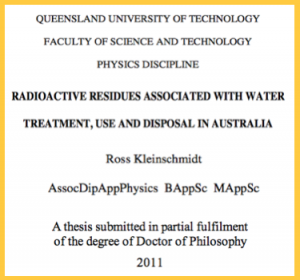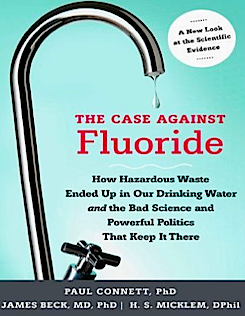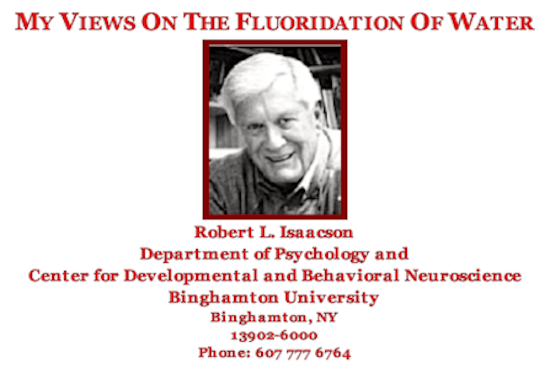The info in the papers below is probably a little distorted by population,
food and water moving beteen counties. Also in the fluoridated areas
some households may have water filtration equipment.
Both of these factors could influence the results,
suggesting that the damage from fluoridation
is probably even more than these
papers would suggest.


Full Text → HERE



FULL TEXT → HERE ←

This paper does not mention fluoride but needs to be considered
with previous research into Underground Water in Queensland.
Ross Kieinschmit may not be aware of the
existence of this government research.


Full original text → HERE ←


Exposure To Fluoridated Water And Attention Deficit Hyperactivity Disorder
Prevalence Among Children And Adolescents In The United States:
An Ecological Association.
by
Ashley J. Malinand & Christine Till
New – Link to original text → HERE
SEE ALSO ↓




Original → HERE ←



The National Health Federation
P.O. Box 688, Monrovia, California 91017
e-mail: contact-us@thenhf.com
Washington, D.C., 20002
ABSTRACT: Vitamin C plays an important role in the orderly deposition of fluoride into various tissues. In higher fluoride areas, Vitamin C increases fluoride excretion and normalizes soft and hard tissue fluoride levels and thus prevents the development of fluorosis. At lower fluoride levels, Vitamin C increases the incorporation of fluoride into teeth. Fluoridation of water systems in not the solution to optimal incorporation of fluoride into teeth; in cases of Vitamin C deficiency, fluoridation may lead to fluorosis.
(21) Hardwick & Bunting, J. Dent. Res. 50 (Supplement, Pt. 1), 1212 (1971)
– 7 August 1974 –
While fluoridation of public water systems has been advocated and encouraged by the national and state public health services, a number of questions concerning the need to add fluoride to public waters have gone unanswered.
Mother’s milk, containing as little as 0.01 to 0.05 ppm fluoride confers as much caries resistance on the child as other infants consuming 1 to 2 ppm fluoride present in commercially prepared formulas (1, 2).
In unfluoridated areas, containing natural fluoride levels of 0.1 to 0.5 ppm and even less, there exists a certain part of the population that are free of caries. In fact, in Nigeria, a population has been found where over 98% of the population is caries free and the fluoride level in their water is within the above range (3).
In a study at Great Lakes Naval Base, the previous life-long residence of caries-free recruits, were examined to determine if any trace elements could be correlated with the low incidence of caries.
The level of fluoride in the drinking water was NOT [our emphasis] implicated.
It has also been noticed that primitive areas in which the people of the area eat unrefined food have a relatively low caries rate as compared to later when these areas became “civilized” and their diets begin to consist of more refined foods.
In these cases, caries rates often soar and addition of fluoride to the water supply is unable to restore the previous caries rate (5, 6, 7).
In areas and among people where nutrition is poor, mottling is observed at levels below the 1 ppm level used to fluoridate public water systems (at levels as low as 0.4 ppm fluoride).
This has been noticed in India (8) as well as among American Negroes whose mottling rate, in the 1-ppm range is higher than that of whites in the same area.
In a comprehensive study in Japan, the fluoride levels associated with the lowest incidence of caries ranged from 0.2 to 0.4 ppm (9).
In the 1930’s it was found that the ingestion of fluoride causes scurvy-like symptoms and that this was associated with a decrease in the Vitamin C levels of various tissues. Similarities in the symptoms of scurvy and mild fluorosis were also observed (10, 11).
In 1954, in an area containing 0.34 to 0.8 ppm fluoride in the water, 23% of the children 4-7 years old exhibited mottling (dental fluorosis). The Vitamin C contents in blood for normal children (without mottling) averaged 0.78 mg %. In the mottled enamel group, the blood Vitamin C levels of most children were extremely low (0.15 to 0.3 mg % in 29%, and 0.0 to 0.15 mg % in 31%. Treatment of these subjects with Vitamin C brought substantial improvement (12).
NOTE → In 1964-65, the death rate of guinea pig population in Australia had reached epidemic proportion. (The Guinea pig is the only non-primate known that cannot synthesize its own Vitamin C). This death rate was eventually attributed to slightly higher levels of fluoride in feed pellets. Symptoms of sub-acute Vitamin C deficiency were observed. Fluorosis was diagnosed as the cause of death (13). In rats and mice (both of which synthesize their own Vitamin C, no such death rate was reported. U.S.P.H.S. experiments are performed with rats – they do not use guinea pigs (14). Both in the U.S. (15) and Russia (16) Vitamin C is recognized as being capable of retarding the development of fluorosis.
In guinea pigs exposed to fluoride, Vitamin C was found to normalize altered blood Ca, P, and sugar levels, as well as fluoride levels and ash contents in teeth and bone, and fat glycogen, and fluoride levels in the liver. Fed to men exposed to elevated fluoride uptakes, 100mg of Vitamin C increased the excretion of fluoride from 3-5.5 mg/day to 6-8.5 mg/day (17).
Most important, however, are the following findings:
1.) in guinea pig, fluoride added to the diet cannot make teeth more insoluble (caries-resistant) than the addition of Vitamin C to the diet and-
2.) in low fluoride areas, dietary supplementation with Vitamin C leads to fluoride deposition in teeth equal to the of higher fluoride areas (18, 19).
In conclusion, it appears that Vitamin C is and essential factor in the deposition of fluoride in, as well as the exclusion of fluoride from, various tissues in the body.
While increased fluoride in teeth had been correlated to caries-resistant of teeth, adequate Vitamin C levels in the diet in areas of 0.1 to 0.5 ppm fluoride (and even 0.01 to 0.05 ppm in the nursing infant) leads to adequate uptake by the teeth. Indeed in animals that manufacture there own Vitamin C (e.g. rats), Fluoride is found not to have a caries protective effect until it reaches levels of 10-20 ppm (14); at these levels it acts as a strong antibacterial in the mouth.
The indiscriminate fluoridation of water systems is not the solution to the problems of tooth decay. In the absence of sufficient Vitamin C, fluoridation will lead to Vitamin C depletion, dental fluorosis, and to abnormal levels of metabolites in blood tissues.
Adequate intake of Vitamin C may explain why people or populations in low fluoride areas can be caries-free.
REFERENCES:
(1) Y. Ericsson, U. Ribelius, Caries Research 5, 78 (1971);
(2) F.J. McClure, Personal communication.
(3) A. Sheiham, British Dental Journal 123, 144 (1967;
(4) J.P. Quinn, NDRI-PR-68-03, (June 1968) 11pp. US Nat.Tech. Inf.
Serv. Reo. No. AD0839 129;
(5) S.J. Barnaud Journal 2, Med. Trop. 29, 593 (1969);
(6) J.A. Cran, Australian Dental Journal 2, 277 (1957);
(7) F. Prader, Schweiz. Mschr. Zahnhk. 71 885 (1961);
(8) R.S. Nanda, Indian Journal of Dental Research 60, 1470 (1972);
(9) Y. Imai, Koku Eisei Gakkai Zasshi 22, 144 (1972);
(10) P.H. Phillips, J. Biol. Chem. 100, (Proc. Am. Soc. Biol. Chem.
Lxxix (1933);
(11) P.H. Phillips, F.J. Stare, C.A. Elvenhem, J. Biol.
Chem. 106, 41 (1934);
(12) N.A. Ivanova, Voprosy Okhrany Materinstva I
Detstva 4, 29 (1959);
(13) F.F.V. Atkinson, G.C. Hard, Nature 211, 429 (1966);
(14) N.M. Stiles, National Institute Of Dental Research,
Personal Communication;
(15) J.W. Suttie, P.H. Phillips, The Pharmacology and
Toxicology of Fluorine,
J.C. Muhler, M.K. Hine, Ed. (Bloomington, Indiana
University Press, 1959) pp 70-7;
(16) V.S. Andreeva Voprosy Okhrany Materinstva I Detstva 4, 25 (1959);
(17) R.D. Gabovich, P.N. Maistruck, Voprosy Pitaniya 22, 32 (1963);
(18) D. J. Thompson, P. H. Phillips, J. Dent. Res. 45, 845 (1966);
(19) D. Triers, C.G. Elliott, M.D. Smith, J. K. Dent.
Res. 47, 1171 (1968);
(20) W. Buttner, Advances in fluorine Research and
Dental Caries Prevention,
J. L. Hardwick, H.R.Held, K.G. Konig, Ed.
(New York Pergamon Press, 1965) pp. 19-30;

Watch also ↓
by John A. Yiamouyiannis

VITAMIN C REDUCTION OF F. INDUCED
EMBRO-TOXICITY IN RATS
Department of Zoology, University School of Sciences,
Gujarat University,
Ahmedabad 380 009, India
R J Verma, D M Guna Sherlin
Jai Research Foundation, Vapi,
Valvada 396 108, India
Oral administration of sodium fluoride (40 mg/kg body weight) from day 6 to 19 of gestation caused, as compared to control, significant reductions in body weight, feed consumption, absolute uterine weight and number of implantations. Significantly higher incidence of skeletal (wavy ribs, 14th rib, <6 sternal centre, dumbell-shaped second and fifth sternebrae, incomplete ossification of skull and thickening of tibia) and visceral (subcutaneous haemorrhage) abnormalities were also observed in NaF-treated dams than that of control. Oral administration of vitamin C (50 mg/kg body weight) and vitamin E (2 mg/0.2 ml olive oil/animal/day) from day 6 to 19 of gestation along with NaF significantly ameliorates NaF-induced reductions in body weight, feed consumption, absolute uterine weight (only with vitamin E treatment) and number of implantations. As compared with NaF-treated alone, the total percentageof skeletal and visceral abnormalities were significantly lowered in fluoride plus vitamin C-treated animals. Vitamin E was less effective.
These findings suggest that vitamin C significantly reduced the severity and incidence of fluoride-induced embryotoxicity in rats. ♦
Key Words: fluoride • vitamins • embryotoxicity • amelioration
Human & Experimental Toxicology, Vol. 20, No. 12, 619-623 (2001)

“THE CASE AGAINST FLUORIDE”


The book concludes that, if proposed today, fluoridation of drinking water to prevent tooth decay would stand virtually no chance of being adopted, given the current status of scientific knowledge.
In part one of The Case Against Fluoride, “The Ethical and General Arguments Against Fluoridation”: The requirement for the informed consent of the patient before administration of a medication is a basic human right. Yet with fluoride, which is added to drinking water as a therapeutic intervention, no such permission is sought or given. The process is enforced on every member of the population. The authors explore this fact in the context of medical ethics. Another aspect is the efficacy of fluoridation as a therapy, which, the authors argue, is marginal at best and deleterious at worst. The fluoride used for water fluoridation is not of pharmaceutical grade, but is in fact a chemical waste by-product. The lack of any rigorous studies as to the efficacy of fluoridation programs, the authors contend, means that the whole process is experimental.
There is no control of “dose”— how much fluoride anyone receives from the water.
In the case of water fluoridation, according to the above authors, the chemicals that go into the drinking water that more than 180 million people drink each day in the United States are not even pharmaceutical grade, but rather a hazardous waste product of the phosphate fertilizer industry. It is illegal to dump this waste into the sea or local surface water, and yet it is allowed in our drinking water. To make matters worse, this program receives no oversight from the Food and Drug Administration, and the Environmental Protection Agency takes no responsibility for the practice. And from an ethical standpoint, say the authors, water fluoridation is a bad medical practice; individuals are being forced to take medication without their informed consent; there is no control over the dose and no monitoring of possible side effects.
Acute high oral exposure to fluoride may lead to nausea, vomiting, abdominal pain, diarrhea, drowsiness, headaches, polyuria and polydipsia, coma, convulsions, cardiac arrest, and death.
Historically, fluoride was quite expensive for the world’s premier chemical companies to dispose of, but in the 50s and 60s, Alcoa and the entire aluminum industry—with a vast overabundance of the toxic waste—somehow sold the FDA and our government on the insane (but highly profitable) idea of buying this poison and then injecting it into our water supply as well as into the nation’s toothpastes and dental rinses. Consider also that when sodium fluoride is injected into our drinking water, its level is approximately one part-per-million (ppm), but since we only drink one-half of one percent of the total water supply, the hazardous chemical literally “goes down the drain” and voila—the chemical industry not only has a free hazardous waste disposal system, but we have also paid them with our health and our pocketbooks for the process.
The aluminum and phosphate fertilizer industries were not alone. The American government’s atomic weapons program was also producing huge amounts of fluoride and was getting sued by famers for the damage done to their cattle.


↑ ↑ ↑ Very Large File ↑ ↑ ↑

~ EVIDENCE SHOWS FLUORIDATION DANGER ~
by Paul Connett, PhD
Professor Emeritus of Environmental Chemistry,
St. Lawrence University, Canton,
Currently, I am traveling in Italy giving presentations on waste management. I have been forwarded a copy of your editorial ridiculing any notion that fluoridation could possibly cause any health problem and that practice is extremely effective at reducing tooth decay.
I will leave your councilors to judge the quality of the evidence that I will share with them on March 14. I write now because I am upset with the bullying tone you have adopted with one of your councilors, Amy Valentine. It is well known that if people are unable to answer a disturbing message they begin by attacking the messenger. You have chosen to do so in this case using the authority of local dentists, the American Dental Association and the Centers for Disease Control and Prevention. However, on this particular issue all these sources are highly suspect because of their very aggressive and long-term promotion of this practice.
It is simply not enough to parrot the phrase that fluoridation is “safe and effective” to win the case. It is incumbent on those who support this most unusual practice (what other chemical is added to the public water supply to treat people rather than treat the water?), which has been rejected by most industrial countries, to provide the scientific evidence for their claims.
To offset the 23 studies from India, Iran, Mexico and China which have shown that high doses of fluoride are associated with lowered IQ in children, where are the studies of the IQ of children living in Plattsburgh or any other fluoridated community in the U.S.? I am not aware of any. Why have they not been done?
The key question, of course, is whether there is an adequate margin of safety between the levels which have caused this harm in other countries and the levels experienced by children in this country drinking uncontrolled amounts of fluoridated water. The lowest level estimated at which IQ was lowered in one of these studies was 1.8 ppm (Xiang et al., 2003). Can you find a single toxicologist or pharmacologist who will tell you that offers an adequate margin of safety for all children exposed to fluoridated water at 1 ppm? For that matter, will they also tell you that there is an adequate margin of safety for all the other health effects discussed in the 507-page report by the National Research Council, “Fluoride in Drinking Water” published in March 2006? Three of the authors of that report don’t think so and have stated so in public.
On the issue of effectiveness, where is the peer-reviewed, published, scientific evidence that the teeth of children in Plattsburgh are “sturdier” than children in non-fluoridated communities in the area? You have none — only anecdotal reports. In fact, a study commissioned by the N.Y. Department of Health, which examined tooth decay in third graders, found absolutely no relationship between tooth decay averaged by county and percentage of the county’s population drinking fluoridated water! Meanwhile, the data collected by the World Health Organization shows no difference in tooth decay in 12 year-olds between fluoridated and non-fluoridated countries .
In my view adding fluoride — a known toxic substance — to the public drinking water at 250 times the level naturally present in mother’s milk (0.004 ppm) is both reckless and foolish, especially now that even promoters of fluoridation like the CDC admit that fluoride works topically, not systemically, i.e. it works by acting on the surface of the tooth not from inside the body (CDC, 1999, 2001).
Not only did your editorial writer question my concerns about fluoride’s ability to damage the brain, but he or she also questioned my suggestion that fluoride also damages the teeth. That’s strange because the CDC has reported that 32 percent of American children have dental fluorosis, a mottling and discoloration of the teeth caused by ingesting fluoride before the permanent teeth have erupted.
While the largest proportion of children thus affected have the condition in its very mild form, over 3-4 percent of children have the condition in its moderate or severe forms, in which 100 percent of the enamel is affected. Moreover, while these enamel defects can be covered by expensive veneers (about $1,000 per tooth) the worrying aspect about this is that it is generally agreed that dental fluorosis is the first indication that the child’s developing body has been over-exposed to fluoride.
Thus, the key question then becomes, while the fluoride is damaging the growing tooth by some systemic mechanism, what other tissues might it be damaging without this obvious and visible telltale sign? This underlines the significance of the IQ studies from countries which do not have a fluoridation program to protect.
So let’s examine the science here, please, not just the reiteration of long-held beliefs.
→ Fluoridation Omission And Errors ←
by
Philip R.N. Sutton
Former Senior Lecturer in Dental Science
University of Melbourne


by Staff Writers
Kobe, Japan (SPX) 23 June 2016




OUR COPY → HERE ←
↓ 25 July 2013 ↓

Full text → HERE
Go on to: ↓



![]()

![]()



















